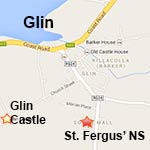About St. Fergus’ National School
St. Fergus’ National School is a co-educational primary school located in the heart of Glin village, overlooking the scenic Shannon Estuary in West Limerick. We are proud to serve the children of our local community in a warm, inclusive, and nurturing environment.
Our School Team
St. Fergus’ NS is an 8-teacher school led by a dedicated and experienced team, which includes:
-
1 Administrative Principal
-
6 Mainstream Class Teachers
-
2 Special Class Teachers supporting children with Autism
-
2 Full-Time Special Education Teachers (SET)
-
Additional SET support (7.5 hours per week) from a shared teacher working across local schools
-
7 Special Needs Assistants (SNAs) who provide vital support for pupils with additional learning needs
In addition to our teaching staff, the school also benefits from:
-
A full-time school secretary
-
A school caretaker
-
A cleaner, ensuring a safe and hygienic environment for all
Our staff work closely together to create a positive, inclusive, and child-centred atmosphere where every pupil is supported to reach their full potential—academically, socially, and emotionally.
Mrs Caroline Gee
Mrs. Rosie Ambrose
Mrs Caroline Dalton
Mr. Seamus Lehane
Mrs Katrina Fitzgerald
Mr. Robert Browne
Mrs Louise McCoy
Our School Story
St. Fergus’ National School has been at the heart of the Glin community since it opened its doors in 1963. The school was built to replace the original National School, which stood just 200 yards away on The Mall. That original school building, now serving as a local community hall, dates back to 1843 and was opened under the principalship of Mr. Michael Stackpoole—a poet and former hedge-school teacher.
A Glimpse Into the Past
The early roll books from the old school paint a vivid picture of life in Glin during the 19th century. Pupils ranged in age from 4 to 17, and the occupations of their parents—feather-mongers, butter buyers, egg dealers, shoemakers, coopers, blacksmiths, tailors, and boat-builders—highlight the rich economic and social fabric of the time.
Growth and Change
When St. Fergus’ opened in 1963, it operated as two schools under one roof:
- St. Fergus Junior School
- St. Fergus Senior School
There were six classrooms, six teachers, and 228 pupils enrolled. Over the decades, the school has adapted to meet the changing needs of the community. A significant extension was added in 1989, officially opened by Cardinal Tomás Ó Fiaich. This included a school hall, kitchen, toilets, offices, and additional rooms. A stage and sound system were added in 2001 to enhance school performances and events.
In 1967, Ballygoughlin National School was amalgamated with St. Fergus’, bringing 43 more pupils via the newly introduced School Bus System from the Department of Education.
School Leaders Through the Years
Junior School Principals:
- Mrs. Nora Fennell (first principal in 1963)
- Mrs. Kathleen Fitzgerald (appointed in 1964)
- Mrs. Marie Collins (principal from 1992 to 1999)
Senior School Principals:
- Mr. James Duggan (first principal in 1963)
- Mr. Tom McKeon (1972)
- Mr. Bernard Stack (1974)
- Mr. John A. Culhane (1992–2011)
In 1999, the Junior and Senior schools amalgamated, and Mr. John A. Culhane became the first principal of the newly unified St. Fergus’ NS. He was succeeded by Mrs. Deirdre Kennelly in September 2011, who continues to lead the school today.
Recent Improvements
The school has seen many modern upgrades over the years:
- In 2005, the school was repainted, new tables and chairs were introduced, old desks were replaced, and classrooms received blinds and new flooring, funded by the Department of Education.
- In 2009, on the advice of the Department’s Inspector, classroom spaces were expanded by merging rooms to better accommodate the New Primary Curriculum and increasing class sizes.
- All classrooms are equipped with high ventilation windows, ensuring a fresh and comfortable learning environment throughout the year.
This long tradition of education, community support, and ongoing development continues to shape St. Fergus’ NS into a modern, inclusive, and forward-thinking school that remains deeply rooted in the heritage of Glin.
Our School Environment & Facilities
At St. Fergus’ National School, we take pride in offering a safe, inclusive, and well-equipped environment that supports both learning and play.
A Green School
In June 2011, St. Fergus’ NS was awarded Green School Status in recognition of our commitment to environmental awareness and sustainable practices. Our Green Flag proudly flies on the flagpole located on the green area at the front of the school, along with our Active Flag, School Flag and Cineáltas Flags—visible symbols of the whole school community’s efforts to care for the environment and each other.
Outdoor Play and Recreation
We understand the importance of outdoor activity for children’s health and development. Our school is well equipped with age-appropriate outdoor facilities:
*Two playgrounds:
One for Junior Infants to Second Class (Naíonáin – Rang 2)
A separate yard for Third to Sixth Class (Rang 3 – Rang 6)
School Playground: Opened in September 2011 after extensive fundraising efforts, this dedicated play space is specifically designed for younger pupils (Naíonáin to Rang 2).
Basketball Court and Playing Field: Available to older pupils on a rota basis, providing opportunities for team sports and physical activity.Growing to Meet New Needs
As our school community continues to grow, so too does our infrastructure:
In the 2023–2024 school year, three modular buildings** were added to accommodate increasing enrolment and to provide a dedicated space for one of our Autism Classes.
We are currently at the planning permission stage for a permanent school extension, which will allow us to further enhance our learning environment and cater for future needs.










